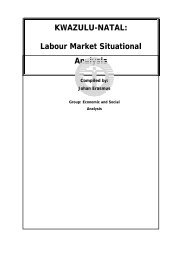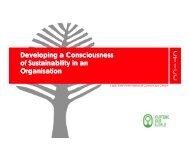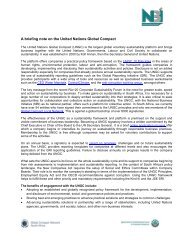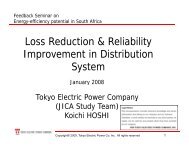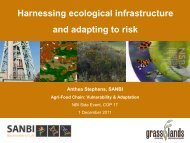Sustainable Forest Finance Toolkit - PwC
Sustainable Forest Finance Toolkit - PwC
Sustainable Forest Finance Toolkit - PwC
- No tags were found...
You also want an ePaper? Increase the reach of your titles
YUMPU automatically turns print PDFs into web optimized ePapers that Google loves.
Special places briefing note 1 of 4New Application HOMEWhat is the issue?For the purposes of this briefing note, the term ‘specialplaces’ is used as a generic term for areas with uniquequalities within the forest landscape that typically needspecial attention and treatment. Depending on their featuresand significance, these places can be identified at differentscales (e.g. global, regional, local scale).There is no universally agreed-upon definition of specialplaces. Existing definitions combine scientific and politicaldimensions. The Equator Principles for example, refer toIFC Performance Standard 6: Biodiversity Conservationand <strong>Sustainable</strong> Natural Resource Management, whichcover a range of topics including critical habitats, legallyprotected areas, natural habitats and natural and plantedforests.In general, different stakeholders deem a forest ‘special’ if itincludes one or more of the following characteristics:Biological, ecological and landscape features• Species richness: number of species within a given area• Species endemism: number of species found exclusivelyin that location• Rarity: species and/or ecosystems that are naturally rare• Representation: a site that represents all of the differentecosystems in the area of concern• Significant or outstanding ecological or evolutionaryprocesses, such as key breeding areas, migration routes,unique species assemblages, and so on• Special species or taxa: presence of an umbrella,keystone, indicator, flagship species or species ofconcern, whether at risk or believed to be• Critical habitats: areas of high biodiversity valueConservation features• Threatened species: species that have been identified asthreatened or endangered• Species decline: species whose populations haveundergone significant decline in recent years• Habitat loss: areas that have lost a significant percentageof their primary habitat or vegetation• Fragmentation: areas that have lost connectivity andhave been fragmented into smaller pieces• Large intact areas: areas within a certain minimum sizewith no or minimal human influence• Level of threat: areas facing high or low pressure fromhuman populations or development• Places considered to have rare and exceptional scenicand aesthetic featuresEcosystem services• Ability to supply basic and/or critical services such aswatershed protection, erosion control, and fire/floodcontrol among othersCultural, livelihood, historical and spiritual features• High value to the people who live within or around thesite (e.g. for reasons of religion, history, cultural identity,or dependency for livelihoods); these include religious,historical and archaeological sites• Critical significance to the traditional cultural identity of alocal community• Critical to maintaining local people’s livelihoodsProtected areas – where are they?Protected areas are locations that receive protectionbecause of their environmental, cultural or similar value.Countries often have extensive systems of protected areasdeveloped over many years. These systems varyconsiderably country to country, depending on nationalneeds and priorities, and on differences in legislative,institutional and financial support.The World Database on Protected Areas (WDPA) uses thedefinition of a protected area and marine protected area(MPA) as adopted by IUCN as the main criteria for alocation’s entry into the database.Definition of a protected area:An area of land and/or sea especially dedicated to theprotection and maintenance of biological diversity, and ofnatural and associated cultural resources, and managedthrough legal or other effective means.Source: IUCN (1994). Guidelines for Protected AreasManagement Categories. IUCN, Cambridge, UK and Gland,Switzerland. 261pp.The WDPA is currently the most comprehensive availableglobal spatial dataset on marine and terrestrial protectedareas.It contains crucial information from national governments,non-governmental organisations, academic institutions,international biodiversity convention secretariats and manyothers.It is used for ecological gap analysis, environmental impactanalysis and is increasingly used for private sector decisionmaking.http://www.wdpa.orgPage 32pwc



